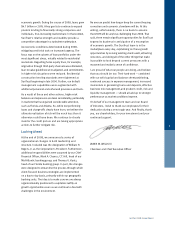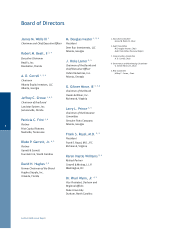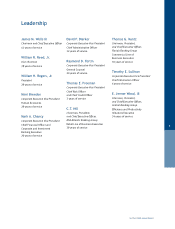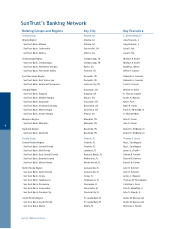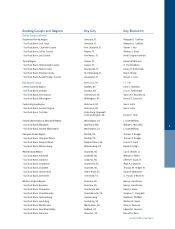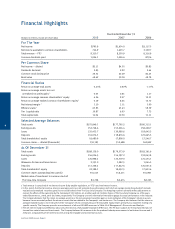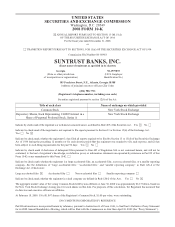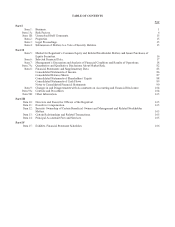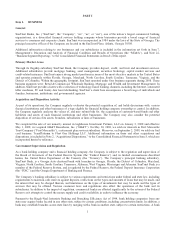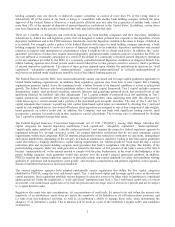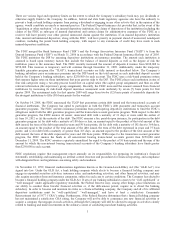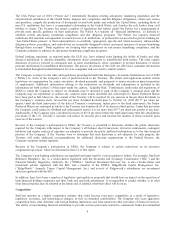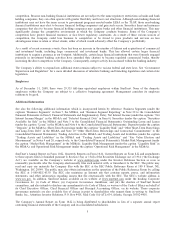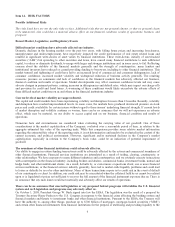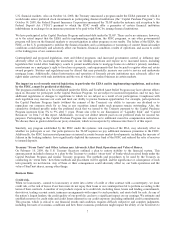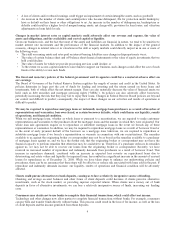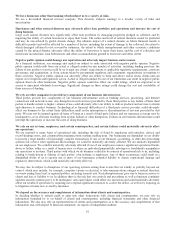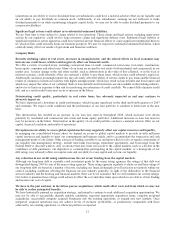SunTrust 2008 Annual Report Download - page 15
Download and view the complete annual report
Please find page 15 of the 2008 SunTrust annual report below. You can navigate through the pages in the report by either clicking on the pages listed below, or by using the keyword search tool below to find specific information within the annual report.There are various legal and regulatory limits on the extent to which the Company’s subsidiary bank may pay dividends or
otherwise supply funds to the Company. In addition, federal and state bank regulatory agencies also have the authority to
prevent a bank or bank holding company from paying a dividend or engaging in any other activity that, in the opinion of the
agency, would constitute an unsafe or unsound practice. The Federal Deposit Insurance Act provides that, in the event of the
“liquidation or other resolution” of an insured depository institution, the claims of depositors of the institution (including the
claims of the FDIC as subrogee of insured depositors) and certain claims for administrative expenses of the FDIC as a
receiver will have priority over other general unsecured claims against the institution. If an insured depository institution
fails, insured and uninsured depositors, along with the FDIC, will have priority in payment ahead of unsecured, nondeposit
creditors, including the parent bank holding company, with respect to any extensions of credit they have made to such
insured depository institution.
The FDIC merged the Bank Insurance Fund (“BIF”) and the Savings Association Insurance Fund (“SAIF”) to form the
Deposit Insurance Fund (“DIF”) on March 31, 2006 in accordance with the Federal Deposit Insurance Reform Act of 2005.
The FDIC maintains the DIF by assessing depository institutions an insurance premium. The amount each institution is
assessed is based upon statutory factors that include the balance of insured deposits as well as the degree of risk the
institution poses to the insurance fund. The FDIC recently increased the amount of deposits it insures from $100,000 to
$250,000. This increase is temporary and will continue through December 31, 2009. Additionally, under the temporary
liquidity guarantee program (the “TLGP”), transactional accounts are fully insured, as described below. The Company’s
banking subsidiary pays an insurance premium into the DIF based on the total amount in each individual deposit account
held at the Company’s banking subsidiary, up to $250,000 for each account. The FDIC uses a risk-based premium system
that assesses higher rates on those institutions that pose greater risks to the DIF. The FDIC places each institution in one of
four risk categories using a two-step process based first on capital ratios (the capital group assignment) and then on other
relevant information (the supervisory group assignment). Recently, the FDIC increased the amount assessed from financial
institutions by increasing its risk-based deposit insurance assessment scale uniformly by seven (7) basis points for first
quarter 2009. The assessment scale for first quarter 2009 will range from twelve (12) basis points of assessable deposits for
the strongest institutions to fifty (50) basis points for the weakest.
On October 14, 2008, the FDIC announced the TLGP that guarantees certain debt issued and the transactional accounts of
financial institutions. The Company has opted to participate in both the FDIC’s debt guarantee and transaction account
guarantee programs. The FDIC assesses insurance premiums from participating depository institutions to fund the FDIC’s
obligations under both the debt guarantee program and the transaction account guarantee program. With respect to the debt
guarantee program, the FDIC insures all senior, unsecured debt with a maturity of 31 days or more until the earlier of
(i) June 30, 2012 or (ii) the maturity of the debt. The FDIC assesses a fee, payable upon issuance, for participation in the debt
guarantee program (a) for debt with a maturity of 180 days or less, an amount equal to the product of the total amount of the
debt issued, the term of the debt expressed in years and 50 basis points; (b) for debt with a maturity of 181 days to 364 days,
an amount equal to the product of the total amount of the debt issued, the term of the debt expressed in years and 75 basis
points; and (c) for debt with a maturity of greater than 365 days, an amount equal to the product of the total amount of the
debt issued, the term of the debt expressed in years and 100 basis points. With respect to the transaction account guarantee
program, the FDIC insures the funds in all non-interest bearing transactional accounts greater than $250,000 until
December 31, 2009. The FDIC assesses a quarterly annualized fee equal to the product of 10 basis points and the sum of the
amount by which the non-interest bearing transactional accounts of the Company’s banking subsidiary have funds greater
than $250,000 in each account.
FDIC regulations require that management report annually on its responsibility for preparing its institution’s financial
statements, establishing and maintaining an internal control structure and procedures for financial reporting, and compliance
with designated laws and regulations concerning safety and soundness.
On November 12, 1999, financial modernization legislation known as the Gramm-Leach-Bliley Act (the “GLB Act”) was
signed into law. Under the GLB Act, a bank holding company which elects to become a financial holding company may
engage in expanded securities activities, insurance sales, and underwriting activities, and other financial activities, and may
also acquire securities firms and insurance companies, subject in each case to certain conditions. The Company has elected to
become a financial holding company under the GLB Act. If any of our banking subsidiaries ceases to be “well capitalized” or
“well managed” under applicable regulatory standards, the Federal Reserve may, among other things, place limitations on
our ability to conduct these broader financial activities or, if the deficiencies persist, require us to divest the banking
subsidiary. In order to become and maintain its status as a financial holding company, the Company and all of its affiliated
depository institutions must be “well-capitalized,” “well-managed,” and have at least a satisfactory Community
Reinvestment Act of 1977 (“CRA”) rating. Furthermore, if the Federal Reserve determines that a financial holding company
has not maintained a satisfactory CRA rating, the Company will not be able to commence any new financial activities or
acquire a company that engages in such activities, although the Company will still be allowed to engage in activities closely
related to banking and make investments in the ordinary course of conducting merchant banking activities.
3


